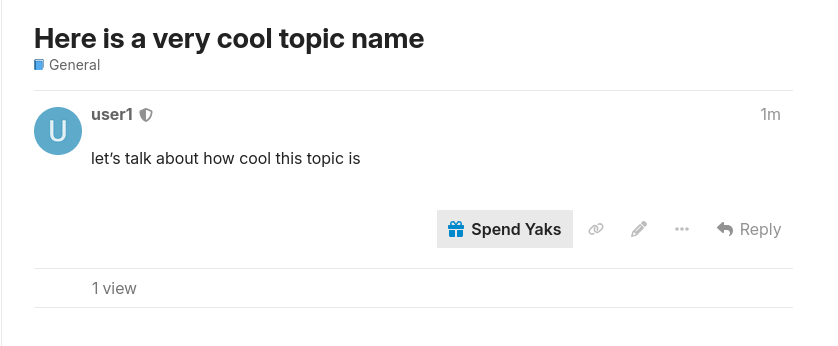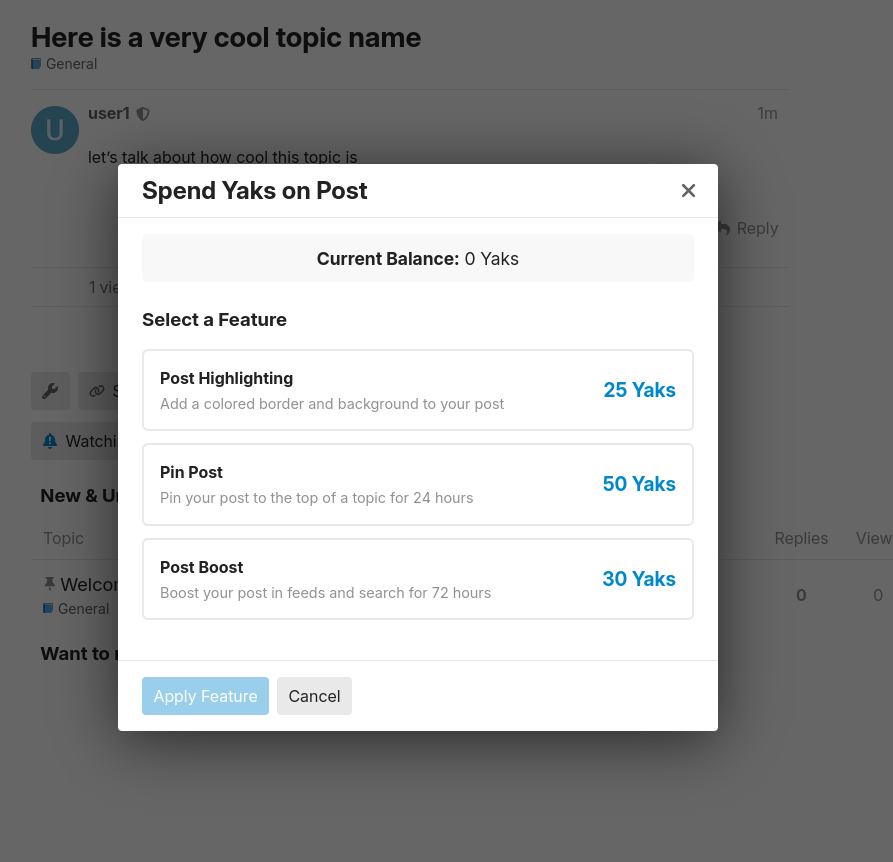Building Yaks: A Virtual Currency System for Discourse (Part 2: Features and Expiration)
In Part 1, I covered the backend architecture for Yaks: wallets, transactions, and the service layer. The database models were in place, but the system could only apply one feature (post highlighting) and had no way to clean up expired features.
Part 2 covers:
- Implementing topic pinning (our second feature)
- Refactoring the service layer to be truly modular
- Building an expiration system with background jobs
- Starting the admin configuration UI


Topic Pinning
Topic pinning lets users spend Yaks to pin their topic to the top of its category for a configurable duration. This uses Discourse's native pinning mechanism, but requires currency to access.
Why This Feature Matters
Forums prioritize content by recency. Older discussions get buried. Topic pinning gives users a way to temporarily boost visibility for important discussions without needing moderator intervention.
The constraint is time. After the configured duration expires, the pin is removed and the topic returns to normal sorting.
The Service Architecture Problem
When implementing topic pinning, I hit an architectural issue. The existing
YakFeatureService.apply_feature method was post-centric:
def self.apply_feature(user, feature_key, related_post, feature_data: {})
# ... validation logic ...
feature_use = YakFeatureUse.create!(
user: user,
yak_feature: feature,
related_post: related_post, # Always requires a post
feature_data: feature_data
)
end
This design assumed every feature applies to a post. But topic pinning
applies to a topic, not a post. I could hack around it by passing
related_post.topic, but that's wrong. The service should support both
contexts.
Looking at the implementation, the issue was clear. The service wasn't modular at all. It was built for posts and only posts. Adding topic support meant refactoring the core design.
Refactoring the Service
The fix was adding support for both posts and topics:
# Old (post-centric)
def self.apply_feature(user, feature_key, related_post, feature_data: {})
# New (modular, all keyword)
def self.apply_feature(
user:,
feature_key:,
related_post: nil,
related_topic: nil,
feature_data: {}
)
Now the service accepts either a post or a topic (or neither, for user-level features like custom flair). Making all parameters keyword arguments forces explicit call sites, which prevents mistakes when you have multiple optional params.
Validation got context-specific methods:
def self.can_apply_to_post?(feature_key, post, user)
return false if post.trashed? || post.deleted_at.present?
return false if post.user_id != user.id
# Check for existing active feature
!YakFeatureUse.exists?(
user: user,
yak_feature: YakFeature.find_by(feature_key: feature_key),
related_post: post,
expires_at: Time.zone.now..Float::INFINITY
)
end
def self.can_apply_to_topic?(feature_key, topic, user)
return false if topic.closed || topic.archived
return false if topic.user_id != user.id
# Check for existing active feature
!YakFeatureUse.exists?(
user: user,
yak_feature: YakFeature.find_by(feature_key: feature_key),
related_topic: topic,
expires_at: Time.zone.now..Float::INFINITY
)
end
This pattern will scale. When we add user-level features (custom flair),
we'll add can_apply_to_user? without touching the core service logic.
Integrating with Discourse's Topic Pinning
Discourse has built-in topic pinning. The Topic model has an
update_pinned method:
duration = feature.duration_hours.hours
topic.update_pinned(true, false, duration.from_now.to_s)
Three parameters:
pinned- Enable or disable the pinglobal- Pin globally (across all categories) or just in this topic's categorypinned_until- When to automatically unpin (must be a string timestamp)
The third parameter is critical. It must be a string, not a Time object. This caught me during implementation:
# Wrong (creates YakFeatureUse but topic doesn't actually pin)
topic.update_pinned(true, false, feature.duration_hours.hours.from_now)
# Correct
topic.update_pinned(true, false, feature.duration_hours.hours.from_now.to_s)
The feature use was being created, the Yaks were being deducted, but the
topic wasn't pinning. The issue was the timestamp format. update_pinned
silently fails if you pass a Time object instead of a string.
Expiration System
Features need to expire. Each feature has a configurable duration stored in the database. We need a way to clean up expired features and undo their effects.
The Architecture
The system has three parts:
- Regular Job:
ExpireYakFeature- Handles a single expiration - Scheduled Job:
CleanupExpiredYakFeatures- Finds expired features and queues regular jobs - Service Method:
YakFeatureService.expire_feature- Business logic for expiration
The primary expiration mechanism runs at creation time. When a feature use is created, the expiration job is scheduled to run exactly when it expires:
def self.apply_feature(...)
feature_use = YakFeatureUse.create!(...)
if feature_use.expires_at
Jobs.enqueue_at(feature_use.expires_at, :expire_yak_feature,
feature_use_id: feature_use.id)
end
# ...
end
This is efficient. No polling. The job runs exactly when needed.
The Scheduled Job
Runs hourly to find expired features:
module Jobs
class CleanupExpiredYakFeatures < ::Jobs::Scheduled
every 1.hour
def execute(args)
expired_features = YakFeatureUse
.where("expires_at IS NOT NULL AND expires_at <= ?", Time.zone.now)
.where(expired: false)
expired_features.find_each do |feature_use|
Jobs.enqueue(:expire_yak_feature, feature_use_id: feature_use.id)
end
{ processed: expired_features.count }
end
end
end
It queries for expired features (where expires_at is in the past) and
queues a job for each one.
This hourly cleanup job is a safety net. If the server restarts before a scheduled job runs, or if something goes wrong with job scheduling, the cleanup job catches it. It's backup, not the primary mechanism.
Why find_each instead of each? Performance. find_each loads records
in batches (1000 by default) instead of loading everything into memory. If
you have 10,000 expired features, each would load all 10,000 at once.
find_each loads 1000, processes them, loads the next 1000.
The Regular Job
Processes one expiration:
module Jobs
class ExpireYakFeature < ::Jobs::Base
def execute(args)
feature_use = YakFeatureUse.find_by(id: args[:feature_use_id])
return unless feature_use
YakFeatureService.expire_feature(feature_use)
end
end
end
Why a separate job? Fault tolerance. If one expiration fails (database error, bug in the expiration logic), it doesn't stop the others from processing.
The Service Method
Handles the business logic:
def self.expire_feature(feature_use)
feature_key = feature_use.yak_feature.feature_key
case feature_key
when "post_highlight"
remove_post_highlight(feature_use.related_post)
when "topic_pin"
unpin_topic(feature_use.related_topic)
end
feature_use.update!(expired: true)
end
private
def self.remove_post_highlight(post)
return unless post
features = post.custom_fields["yak_features"] || {}
features.delete("highlight")
if features.empty?
post.custom_fields.delete("yak_features")
else
post.custom_fields["yak_features"] = features
end
post.save_custom_fields
end
def self.unpin_topic(topic)
return unless topic
topic.update_pinned(false, false, nil)
end
Expiration removes the visual effects and marks the feature use as expired.
Why mark as expired instead of deleting? Audit trail. Users can see their feature history. Admins can debug issues. Refunds are easier because you have the original feature use record.
Frontend Integration
The frontend needed two things:
- A "Spend Yaks" button on topics
- Context-aware modal that shows appropriate features
Topic Footer Button
Discourse has an API for adding buttons to topic footers:
import { withPluginApi } from "discourse/lib/plugin-api";
export default {
name: "yak-topic-actions",
initialize() {
withPluginApi((api) => {
api.registerTopicFooterButton({
id: "yak-spend",
icon: "coins",
label: "yaks.topic_action.spend",
action() {
const modal = getOwner(this).lookup("service:modal");
modal.show(SpendYaksModal, {
model: {
topic: this.topic,
},
});
},
dropdown() {
return this.site.mobileView;
},
classNames: ["yak-spend"],
dependentKeys: ["topic.closed", "topic.archived"],
displayed() {
return (
this.currentUser &&
this.topic.user_id === this.currentUser.id &&
!this.topic.closed &&
!this.topic.archived
);
},
});
});
},
};
The displayed() function controls visibility. The button only shows if:
- User is logged in
- User owns the topic
- Topic isn't closed or archived
Context-Aware Modal
The modal needed to work for both posts and topics:
export default class SpendYaksModal extends Component {
get isPostContext() {
return !!this.args.model.post;
}
get isTopicContext() {
return !!this.args.model.topic && !this.args.model.post;
}
get postFeatures() {
return this.allFeatures.filter((f) => f.category === "post");
}
get topicFeatures() {
return this.allFeatures.filter((f) => f.category === "topic");
}
get availableFeatures() {
if (this.isPostContext) return this.postFeatures;
if (this.isTopicContext) return this.topicFeatures;
return [];
}
}
One modal, two contexts. The UI adapts based on whether you clicked "Spend Yaks" on a post or a topic.
Admin UI (In Progress)
The final piece is admin configuration. Currently, features and purchase packages are hardcoded. They need to be editable in the UI.
Database-Backed Packages
Created a yak_packages table:
create_table :yak_packages do |t|
t.string :name, null: false
t.text :description
t.integer :price_cents, null: false, default: 0
t.integer :yaks, null: false, default: 0
t.integer :bonus_yaks, null: false, default: 0
t.boolean :enabled, null: false, default: true
t.integer :position, null: false, default: 0
t.timestamps
end
Price is stored as cents (integers) instead of dollars (floats) to avoid floating-point precision issues. A $5.00 package is 500 cents.
The model has helper methods:
class YakPackage < ActiveRecord::Base
def total_yaks
yaks + bonus_yaks
end
def price_usd
price_cents / 100.0
end
def price_usd=(usd)
self.price_cents = (usd.to_f * 100).to_i
end
end
This lets you work in dollars in the UI but store as cents in the database.
CRUD Endpoints
Added REST endpoints to the admin controller:
def packages
packages = YakPackage.ordered
render json: { packages: packages.map { |p| serialize_package(p) } }
end
def create_package
package = YakPackage.new(package_params)
if package.save
render json: { package: serialize_package(package) }
else
render_json_error(package.errors.full_messages.join(", "))
end
end
def update_package
package = YakPackage.find(params[:id])
if package.update(package_params)
render json: { package: serialize_package(package) }
else
render_json_error(package.errors.full_messages.join(", "))
end
end
def delete_package
package = YakPackage.find(params[:id])
package.destroy!
render json: success_json
end
Standard Rails REST pattern. The admin can create, edit, and delete packages without touching code.
Admin UI Structure
The UI follows Discourse's admin plugin pattern (inspired by the Chat plugin):
admin/assets/javascripts/discourse/
├── routes/admin-plugins/show/discourse-yaks-management/
├── controllers/admin-plugins/show/discourse-yaks-management/
├── templates/admin/plugins/show/discourse-yaks-management/
└── initializers/yaks-admin-plugin-configuration-nav.js
The structure creates tabs:
- Settings - Site settings (automatic)
- Management - Custom UI for packages, features, stats
The templates use Discourse's admin components:
<div class="admin-config-page">
<div class="admin-plugin-config-page">
<div class="d-page-header">
<div class="d-page-header__title-row">
<h1 class="d-page-header__title">Yak Management</h1>
</div>
<p class="d-page-header__description">
Manage your virtual currency system. Configure purchase packages
and premium features.
</p>
</div>
<div class="admin-plugin-config-page__content">
<!-- Tables for stats, packages, features -->
</div>
</div>
</div>
This matches Discourse's standard admin page structure. Using the framework's components ensures consistency with the rest of the admin area.
Current Status
The admin UI backend is complete (CRUD endpoints, modals, tables), but the tab navigation isn't working yet. The Settings tab appears, but the Management tab doesn't. This is a routing issue, not a data issue.
The tables work when accessed directly. The functionality is there. The navigation just needs debugging.
What's Next
The immediate task is fixing the admin UI tab navigation. Once that's working, admins will have full control over the system configuration:
- Add/edit/delete purchase packages (price, Yak amounts, bonus structure)
- Configure feature costs and durations (how many Yaks, how long they last)
- View system statistics (total wallets, Yaks in circulation, active features)
After that:
- Implement the earning system (reward quality posts based on configurable criteria)
- Build the remaining features (post pin, post boost, custom flair)
- Add purchase flow integration (Stripe for buying Yaks with real money)
The plugin is functional. Two features work end-to-end. The expiration system is running. The architecture is modular enough to add new features without major refactoring.
Part 3 will cover the earning system and completing the admin UI.
The code is on GitHub: ducks/discourse-yaks